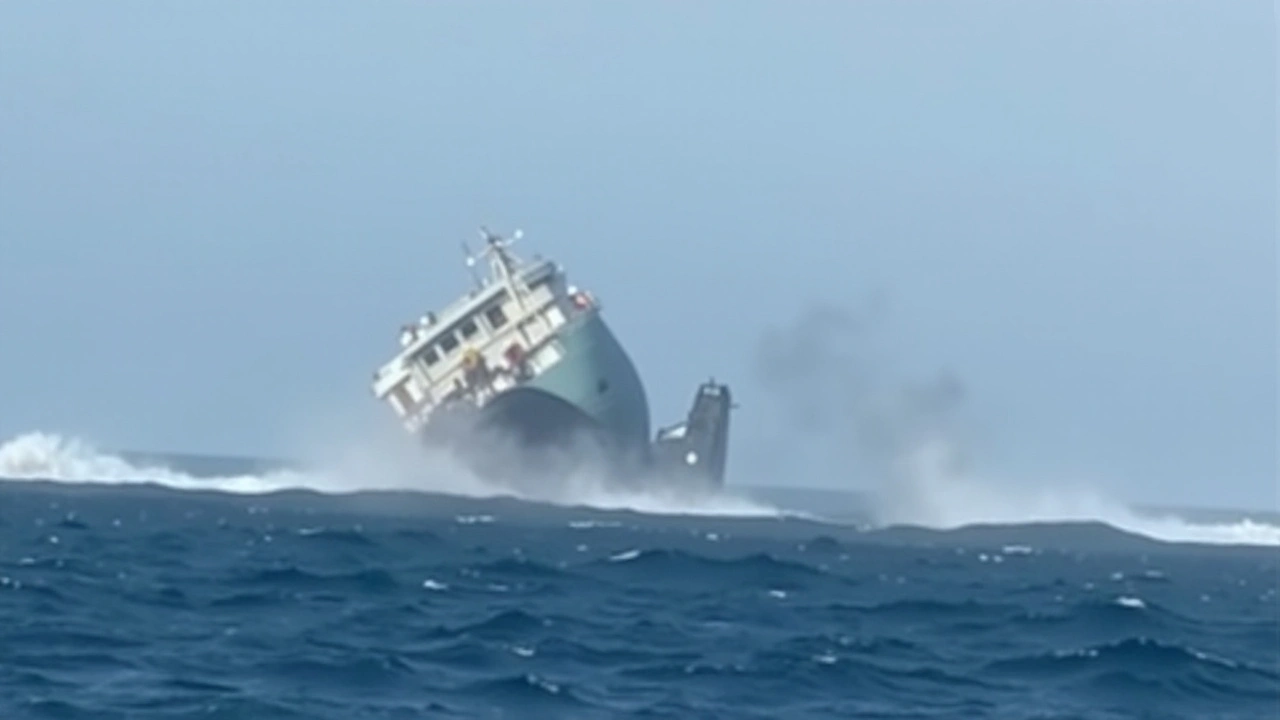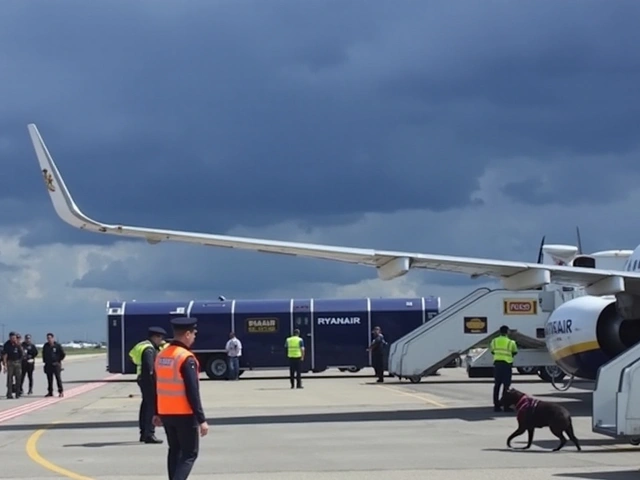The Rescue Operation of HMNZS Manawanui: A Salvage Success
The Royal New Zealand Navy's survey vessel, HMNZS *Manawanui*, suffered a dramatic accident off the coast of Samoa when it ran aground, caught fire, and ultimately sank into the depths of the Pacific Ocean. It presented a dual challenge of a maritime emergency and potential environmental disaster, stirring concerns both at home and across the Samoan seascape. Yet, there was a silver lining that came with an update from the salvage team that worked diligently at the site.
Located in a relatively shallow resting place of 30 meters, the wreck was situated atop a flat rock shelf rather than entangled in rugged coral—a discovery that was fortuitous for the salvage efforts. With anticipation and a touch of apprehension, salvage divers descended upon the scene to examine the condition of *Manawanui*. To their relief, despite the catastrophe above the waves, the vessel's fuel tanks remained intact.
This key discovery meant that the feared extensive diesel spill was averted, as almost all of the ship's 950 tonnes of diesel remained safely within its tanks. Instead, only small amounts of diesel fuel seeped from three specific pipe locations. While this leakage did produce a visible sheen on the water's surface and infused the shoreline with a potent smell of fuel, it was not of the magnitude that would lead to substantial maritime pollution or devastate the local marine ecosystems.
Assessing Environmental and Community Impact
The importance of this development reached beyond environmental circles to the heart of community life in Samoa. Many local fishermen depend on surrounding reefs for their livelihoods and sustenance. Initial fears saw concerns of a catastrophic pollution event that might despoil these vital reefs. However, the isolated leakage assuaged immediate environmental fears, providing a collective sigh of relief among local stakeholders.
The dive team, led by Lieutenant Christian Lloyd, not only focused on safeguarding the environment but also underscored the value of engaging with the local community. His team emphasized the need to remove any debris or hazards from both water and land, recognizing the significance of these actions in preserving the symbiotic relationship the community has with the sea.
The Technical Challenge of Salvage
While the initial discovery of intact tanks was a cause for relief, the mission was far from over. The salvage operation's next phase involved planning a safe and effective way to extract the fuel. As explained by salvage consultant John Riding, the vessel's position in shallow waters granted an opportunity for remote drilling into the hull's side. By bypassing the ship's superstructure, this method proved less invasive and more efficient, minimizing disturbance during fuel extraction.
Adding to the technical challenge, three shipping containers from *Manawanui*'s deck had dislodged during the incident. Drifting along with the tides, they eventually rested on a nearby reef, posing another set of risks to the local ecology. These containers demanded careful handling and removal within the broader salvage operation to prevent further complications.
Unraveling the Mystery: Journey into the VDR
Amidst the physical recovery efforts, divers managed to retrieve a critical asset from the submerged wreck—the vessel's voyage data recorder (VDR). This crucial piece of technology holds the key to deciphering the series of events leading up to the accident. Investigators shall pore over the data, using it to unearth clues that will inform their inquiries into possible failures and oversights.
The New Zealand Defence Force, already touted for its rigorous standards, has initiated a board of inquiry process to dive deep into the circumstances surrounding the mishap. Its objectives are clear: learn from potential mistakes, implement recommendations, and strengthen maritime operations to prevent such accidents in the future.

Looking Forward: A Reflective Pause
In the days, weeks, and possibly months to come, the HMNZS *Manawanui* incident will continue to reverberate through discussions about maritime response, environmental stewardship, and community resilience. The salvage operation reflects not just on the physical act of recovery but also acts as a mirror to examine the interplay of human systems upon which these missions rely.
The story of the *Manawanui* serves as a potent reminder of the sea's power but also of humanity's capacity to adapt, strategize, and overcome challenges through collaboration and expertise. The site where the vessel now lies may transform into a case study, not just for seafarers and salvage crews but also for environmentalists, communities, and defense forces worldwide who strive to harmonize their actions with nature's rhythm.
As the New Zealand Navy absorbs lessons learned and moves forward with innovation and resilience, its efforts showcase the importance of preparedness in managing Nature’s unpredictable theatre. Through shared understanding and mutual care, the path toward a safer and more sustainable maritime future continues to unfold.







Michelle Roque
October 10, 2024 AT 17:17Wow, thats a releif that the fuel didnt spill everywhere lol
Killian Lecrut
October 21, 2024 AT 10:53What a stellar job by the NZ Navy, diving right into the mess like it’s a weekend hobby. The fact that the fuel tanks stayed sealed is almost as surprising as their ability to keep a press conference cool. Kudos to Lt. Lloyd for turning a potential disaster into a textbook case of crisis management. It’s a good reminder that preparedness beats panic any day. Keep the updates coming, we’re all glued to the feed.
Subi Sambi
November 1, 2024 AT 04:29The salvage crew may have found intact tanks, but that doesn’t erase the glaring oversight that let the vessel run aground in the first place. A fire on a ship is rarely a surprise when safety drills are treated as optional. The local fishermen were left fearing a massive spill that could have decimated reefs, all because a simple navigation error was ignored. This incident should be a wake‑up call for stricter protocols. The board of inquiry has its work cut out, and I expect them to dig deep into systemic faults. Anything less would be a half‑hearted excuse.
Joshua Rainey
November 11, 2024 AT 22:05The whole thing reads like a low‑budget movie script. They drove the ship straight onto a reef and then pretended it was an epic adventure. The fact that the fuel tanks didn’t burst is lucky, not a sign of competence. Salvage divers are heroes, no doubt, but they shouldn’t have to clean up a mess that could have been avoided. The Navy’s board of inquiry will certainly love to point fingers at “human error”. In reality it is a cascade of poor decisions. Navigation charts were outdated, crew fatigue was ignored, and emergency procedures were rehearsed on paper only. The diesel leak, though small, still stained the water like a warning sign. Local fishermen saw the sheen and smelled the fuel and that alone hurts livelihoods. The containers drifting onto reefs could become artificial habitats or sources of pollution, depending on how quickly they’re removed. The remote drilling technique sounds clever, but it’s also a gamble with unknown structural stresses. I hope the engineers double‑checked the hull integrity before punching holes. The VDR retrieval is a good move, but data analysis will take time and the community can’t wait. If the inquiry blames a single officer, we’ll see the same pattern repeat. Accountability must be collective, from senior command to deckhands. The Navy should use this as a catalyst for a full overhaul of training standards. Anything less is just damage control. In the end, the sea won’t care how many reports are filed, it only cares about the health of its ecosystems.
Gail Robb
November 22, 2024 AT 15:41One could argue that the whole drama is just a modern myth we tell ourselves to feel superior to nature. The “intact tanks” narrative feeds a comforting illusion of control, while the true lesson is our hubris. Instead of celebrating a “success”, perhaps we should be questioning why we let a vessel become a ticking time‑bomb in the first place. The moral is clear: technology cannot replace respect for the ocean’s power. If we keep glorifying these rescue operas, we’ll never learn humility.
Pradeep Chabdal
December 3, 2024 AT 09:17The technical nuances of remote hull drilling merit a deeper examination beyond the headline. By bypassing the superstructure, the team minimized hydrodynamic disturbance, which is a commendable application of fluid dynamics principles. However, the long‑term structural integrity of the hull after such invasive procedures remains uncertain. A comprehensive metallurgical assessment should accompany the fuel extraction to prevent future failure modes. Such diligence distinguishes true engineering excellence from mere crisis management.
andy heri
December 14, 2024 AT 02:53Great job to everyone involved, especially the divers who put their safety on the line. It’s encouraging to see the Navy engaging with the Samoan community and listening to their concerns. Removing debris and protecting the reefs shows real respect for local livelihoods. Let’s keep that collaborative spirit going as the next phases unfold. Proud of the teamwork displayed here.
Jeremy Perlman
December 24, 2024 AT 20:29Look, the facts are crystal clear, the fuel tanks held up, the leak was minuscule, the diesel sheen was just a surface effect, the containers were recovered, the VDR was retrieved, the board of inquiry is already convened, and the salvage operation is proceeding according to best practices, which means there’s absolutely no reason for alarm; the situation is under control, and any speculation beyond the official reports is simply unnecessary drama.
George Georgakopoulos
January 4, 2025 AT 14:05Sure, the Navy’s “cool press conference” is just a smokescreen, the real story is that they’ve been hiding a secondary leak that sensors missed. The shallow reef hides a network of pipelines feeding a covert operation, and the containers on the reef are not just trash but markers for an undisclosed dump site. The public never sees the full picture because the data is filtered through classified channels. Remember the other “intact tanks” incident that later turned out to be a cover‑up? This smells like another one.
Abirami Nagarajan
January 15, 2025 AT 07:41It’s good to hear the community’s worries were taken seriously and the environment is being protected.
shefali pace
January 26, 2025 AT 01:17Seeing real concern turned into action is truly inspiring, it shows that when people unite, even the biggest ocean challenges can be met with hope and determination, let’s keep this momentum alive for the reefs and the fishermen who depend on them.
sachin p
February 5, 2025 AT 18:53Do we know how long the remote drilling will take before the fuel is fully removed?
sarthak malik
February 16, 2025 AT 12:29The remote drilling setup is designed for a controlled extraction that typically spans several weeks, depending on hull integrity and pressure readings. Engineers will monitor the flow rate continuously and adjust the bore size as needed to avoid breaching the tank walls. The team also plans to use non‑toxic sealants to plug any micro‑fractures that might develop during the process. Overall, the operation balances speed with safety to ensure the diesel stays contained.
Nasrin Saning
February 27, 2025 AT 06:05Let’s keep sharing updates so everyone stays informed and can support the cleanup efforts.
gaganpreet singh
March 9, 2025 AT 23:41It is absolutely reprehensible that we allow such reckless ventures to jeopardize pristine marine ecosystems for the sake of a single vessel’s mission, and this incident serves as a glaring testament to humanity’s ongoing neglect of environmental stewardship, the fact that a massive amount of diesel was perched on a sunken ship for weeks without immediate remedial action is a moral failure of the highest order, we must question the ethics of deploying costly naval assets without robust contingency plans, the community’s reliance on the reefs for sustenance underscores the deep interconnection between human survival and ecological health, yet policies often prioritize strategic interests over local livelihoods, the board of inquiry may delve into procedural oversights, but it must also confront the broader cultural attitude that treats the ocean as a disposable resource, each leak, however small, compounds the cumulative stress on marine biodiversity, and the narrative that this “salvage success” absolves us of responsibility is dangerously complacent, we need a paradigm shift that places preservation at the core of maritime operations, stringent environmental impact assessments should be mandatory before any deployment, and continuous monitoring must be enforced, otherwise history will repeat itself with even graver consequences, let this episode be a catalyst for enduring change, not just a footnote in naval reports.
Urmil Pathak
March 20, 2025 AT 17:17Will the VDR data help prevent future accidents like this?